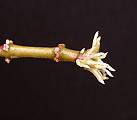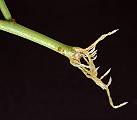

|
|
| About Euphorbiaceae
Cultivation - Vegetative Propagation
|
Propagation of euphorbias from cuttings is the easiest and quickest method for many species, and is also a way to prune an old plant back into shape. Cuttings should be taken with a sharp clean knife, if possible laying the plant down on a clean and smooth surface and using a pulling, rather than pressing motion to obtain a clean and clear cut. Branching species should be cut if possible at the branching point. Solitary plants such as E. bupleurifolia or E. piscidermis can be decapitated to encourage production of side shoots which can later be removed and rooted.
The best time to take cuttings is in the spring when growth starts, but summer is also suitable. Cuttings taken in autumn or winter have little time to root, and so cuttings should only be taken as an emergency to rescue plants suffering from root rot.
The latex appearing after cutting must be completely washed away in a glass of water or by spraying. Cold water stems the flow quickly as does brief exposure to a candle flame or match.
Euphorbias with large leaves should have leaves just above the cut removed with a knife. The cut surface should be left to dry before planting, one or better several days for leafless species. Leafy Madagascan species need only dry a short time. Dusting the cut surface with a hormone rooting powder will help roots form. For euphorbias we recommend 0.1% naphthyl acetic acid and not indolyl acetic acid which is usually found in shops. The planting medium can be the same as for seed sowing with the addition of some sterilised drainage material.
Rooting can take longer than expected but is accelerated by raising the soil temperature to around 25 °C using a thermostatically controlled warming mat. Direct sun should be avoided.
If unrooted cuttings dehydrate, they can sometimes be saved by soaking in water at room temperature until then swell up again and can be replanted.
|
Rooting cuttings |
||
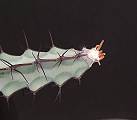 |
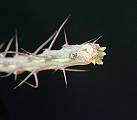 |
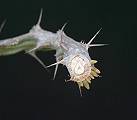 |
| Euphorbia greenwayi var. greenwayi | Euphorbia myrioclada | Euphorbia similiramea |
A fast rooting method, which does not suit all species, is to stand cuttings in a narrow glass and fill up to 2-3 cm with water. Rooting can occur in 10-14 days.
Rooting cuttings in water |
||
Cuttings in water |
Euphorbia cotinifolia ssp. cotinoides |
Euphorbia guiengola |
Some euphorbias that can be rooted from side shoots continue to grow as branches and do not form the typical plant form. The medusa-head species are in this group as well as E. brevitorta, E. groenewaldii, E. tortirama and others. For these the so-called two-step cutting method is required. First a cutting is taken in the normal way. When this has rooted, a second cut is made just above the point where roots have formed and the cut is treated in the normal way. The tip can be re-rooted and when large enough can be cut again. The rooted stump will normally produce a plant of form typical to the species and this can then be removed when large enough from the mother cutting.
Some Madagascan euphorbias (E. francoisii, E. cylindrifolia, E. pachypodioides, E. ankarensis, E. millotii) have been successfully propagated from leaf cuttings. Leaves are gently pulled from the plants (not cut) and put into cubes of rock wool which are then placed on coarse sand in a tray. The surface of the sand should be covered with water (putting the leaves directly into damp sand also works, although with greater losses). Hormone rooting powder and fungicide assist the process. Both gentle heat or a cool position with a plastic cover to increase humidity, should produce the desired result. After 40 days the plants are sufficiently well developed to be potted.
Leaves of E. decaryi, E. primulifolia, E. moratii, E. cremersii and E. decidua will produce roots but do not develop plants. They remain as rooted leaves.
Finally a few words on the toxicity of the latex. Even small amounts can cause painful skin irritation. If you get it on the skin, it should immediately be washed off thoroughly under running water. On no account let the latex come into contact with the eyes or mucous membranes.

